warning VAUXHALL VIVARO C 2020 Owner's Manual
[x] Cancel search | Manufacturer: VAUXHALL, Model Year: 2020, Model line: VIVARO C, Model: VAUXHALL VIVARO C 2020Pages: 289, PDF Size: 10.16 MB
Page 6 of 289

4IntroductionDanger, Warnings andCautions9 Danger
Text marked 9 Danger provides
information on risk of fatal injury.
Disregarding this information may
endanger life.
9 Warning
Text marked 9 Warning provides
information on risk of accident or
injury. Disregarding this
information may lead to injury.
Caution
Text marked Caution provides
information on possible damage to
the vehicle. Disregarding this
information may lead to vehicle
damage.
Symbols
Page references are indicated with 3.
3 means "see page".
Page references and index entries
refer to the indented headings given
in the section table of content.
Thank you for choosing a Vauxhall.
We wish you many hours of
pleasurable driving.
Your Vauxhall Team
Page 13 of 289

In brief111Power windows .....................41
2 Exterior mirrors .....................38
3 Side air vents ...................... 148
4 Selective ride control ..........171
5 Turn lights ........................... 133
Headlight flash ....................131
High beam ........................... 130
Exit lighting .......................... 136
6 Head-up display controls ....120
7 Steering wheel controls ........93
8 Steering wheel paddles ........93
9 Instruments ......................... 104
Driver Information Centre .... 115
10 Button for Driver
Information Centre ..............115
Windscreen wiper and
washer .................................. 94
Rear wiper and washer .........96
11 Head-up display ..................120
12 Air vents .............................. 148
13 Control elements for Info
Display ................................ 11914Info Display ......................... 119
15 Climate control system ........ 140
16 Storage compartment ...........78
17 Storage compartment ...........78
18 AUX input
19 Power outlet .......................... 97
20 Airbag deactivation ...............64
21 USB port ............................... 97
22 Seat heating .......................... 51
23 Electronic Stability Control
and Traction Control ...........170
Tyre deflation detection
system ................................. 238
Stop-start system ................156
Heated windscreen ...............44
Electric child locks ................. 28
Central locking system ..........24
24 Hazard warning flashers .....132
25 Manual transmission ...........167
Automatic transmission .......164
26 Power button ....................... 153
27 Automatic locking ..................2828Ignition switch .....................152
29 Control elements for
Infotainment system
30 Steering wheel adjustment ...93
31 Fuse box ............................. 230
32 Horn ...................................... 94
33 Cruise control ...................... 173
Speed limiter ....................... 176
Adaptive cruise control .......179
34 Bonnet release lever ...........213
35 Anti-theft alarm system .........36
Lane departure warning ......200
Side blind spot alert ............194
Parking assist ...................... 191
Parking heater ....................146
Headlight range adjustment 131
High beam assist ................130
Page 15 of 289
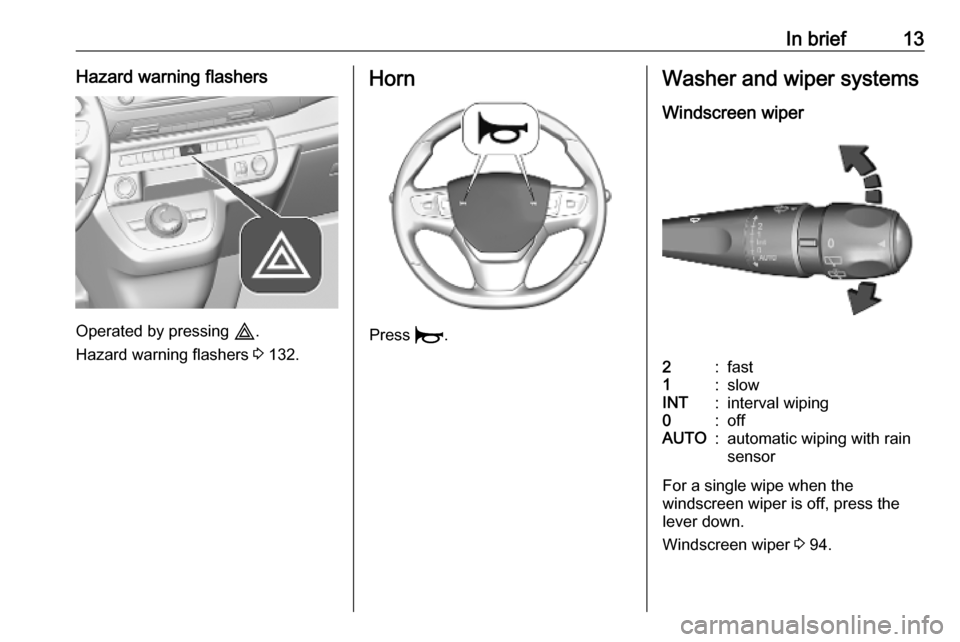
In brief13Hazard warning flashers
Operated by pressing ç.
Hazard warning flashers 3 132.
Horn
Press d.
Washer and wiper systems
Windscreen wiper2:fast1:slowINT:interval wiping0:offAUTO:automatic wiping with rain
sensor
For a single wipe when the
windscreen wiper is off, press the
lever down.
Windscreen wiper 3 94.
Page 22 of 289
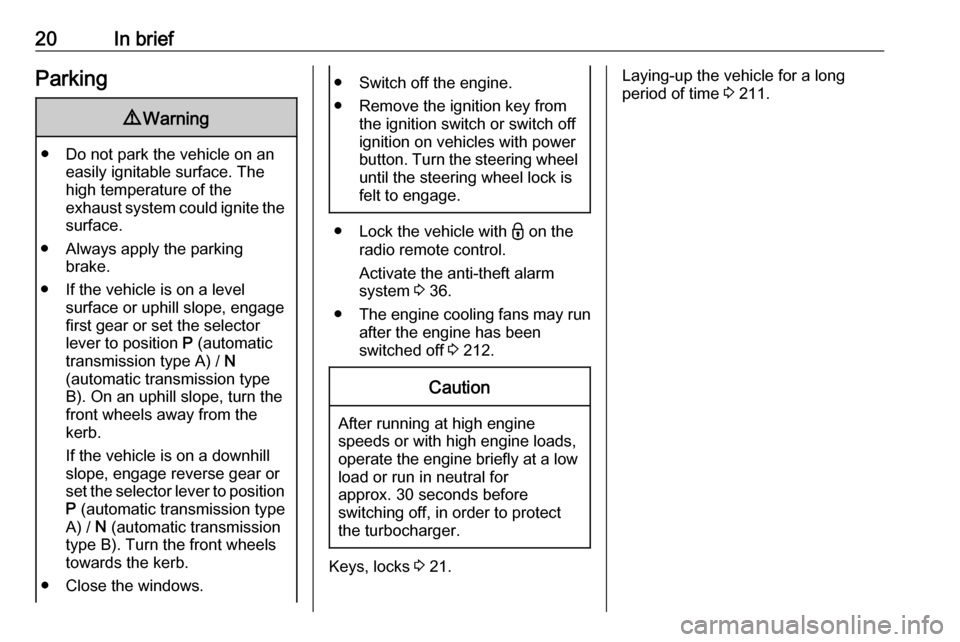
20In briefParking9Warning
● Do not park the vehicle on an
easily ignitable surface. The
high temperature of the
exhaust system could ignite the
surface.
● Always apply the parking brake.
● If the vehicle is on a level surface or uphill slope, engage
first gear or set the selector
lever to position P (automatic
transmission type A) / N
(automatic transmission type B). On an uphill slope, turn the
front wheels away from the
kerb.
If the vehicle is on a downhill
slope, engage reverse gear or
set the selector lever to position P (automatic transmission type
A) / N (automatic transmission
type B). Turn the front wheels
towards the kerb.
● Close the windows.
● Switch off the engine.
● Remove the ignition key from the ignition switch or switch off
ignition on vehicles with power
button. Turn the steering wheel
until the steering wheel lock is
felt to engage.
● Lock the vehicle with - on the
radio remote control.
Activate the anti-theft alarm
system 3 36.
● The engine cooling fans may run
after the engine has been
switched off 3 212.
Caution
After running at high engine
speeds or with high engine loads,
operate the engine briefly at a low load or run in neutral for
approx. 30 seconds before
switching off, in order to protect
the turbocharger.
Keys, locks 3 21.
Laying-up the vehicle for a long
period of time 3 211.
Page 24 of 289
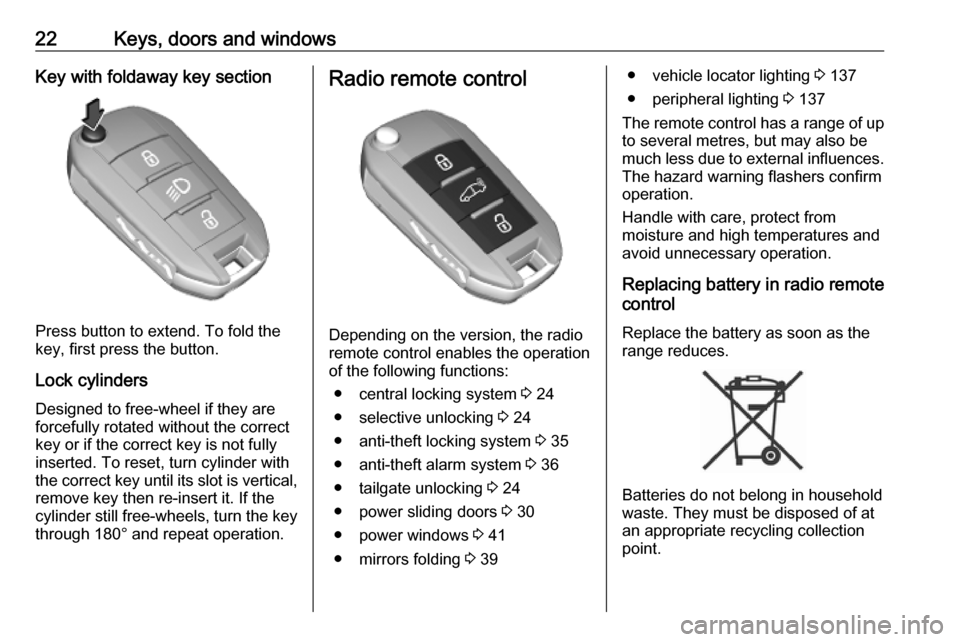
22Keys, doors and windowsKey with foldaway key section
Press button to extend. To fold the
key, first press the button.
Lock cylinders
Designed to free-wheel if they are forcefully rotated without the correct
key or if the correct key is not fully
inserted. To reset, turn cylinder with
the correct key until its slot is vertical, remove key then re-insert it. If the
cylinder still free-wheels, turn the key
through 180° and repeat operation.
Radio remote control
Depending on the version, the radio
remote control enables the operation of the following functions:
● central locking system 3 24
● selective unlocking 3 24
● anti-theft locking system 3 35
● anti-theft alarm system 3 36
● tailgate unlocking 3 24
● power sliding doors 3 30
● power windows 3 41
● mirrors folding 3 39
● vehicle locator lighting 3 137
● peripheral lighting 3 137
The remote control has a range of up
to several metres, but may also be
much less due to external influences. The hazard warning flashers confirm
operation.
Handle with care, protect from
moisture and high temperatures and
avoid unnecessary operation.
Replacing battery in radio remote
control
Replace the battery as soon as the
range reduces.
Batteries do not belong in household
waste. They must be disposed of at
an appropriate recycling collection
point.
Page 28 of 289
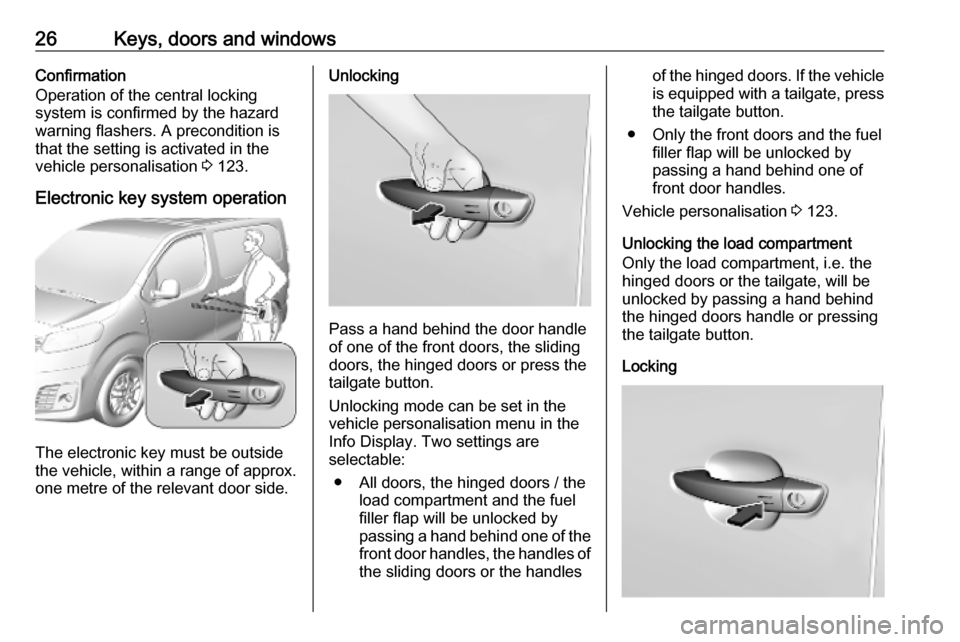
26Keys, doors and windowsConfirmation
Operation of the central locking
system is confirmed by the hazard
warning flashers. A precondition is
that the setting is activated in the
vehicle personalisation 3 123.
Electronic key system operation
The electronic key must be outside
the vehicle, within a range of approx. one metre of the relevant door side.
Unlocking
Pass a hand behind the door handle
of one of the front doors, the sliding
doors, the hinged doors or press the
tailgate button.
Unlocking mode can be set in the
vehicle personalisation menu in the
Info Display. Two settings are
selectable:
● All doors, the hinged doors / the load compartment and the fuel
filler flap will be unlocked by
passing a hand behind one of the front door handles, the handles of
the sliding doors or the handles
of the hinged doors. If the vehicle is equipped with a tailgate, press
the tailgate button.
● Only the front doors and the fuel filler flap will be unlocked by
passing a hand behind one of
front door handles.
Vehicle personalisation 3 123.
Unlocking the load compartment
Only the load compartment, i.e. the
hinged doors or the tailgate, will be
unlocked by passing a hand behind
the hinged doors handle or pressing
the tailgate button.
Locking
Page 29 of 289
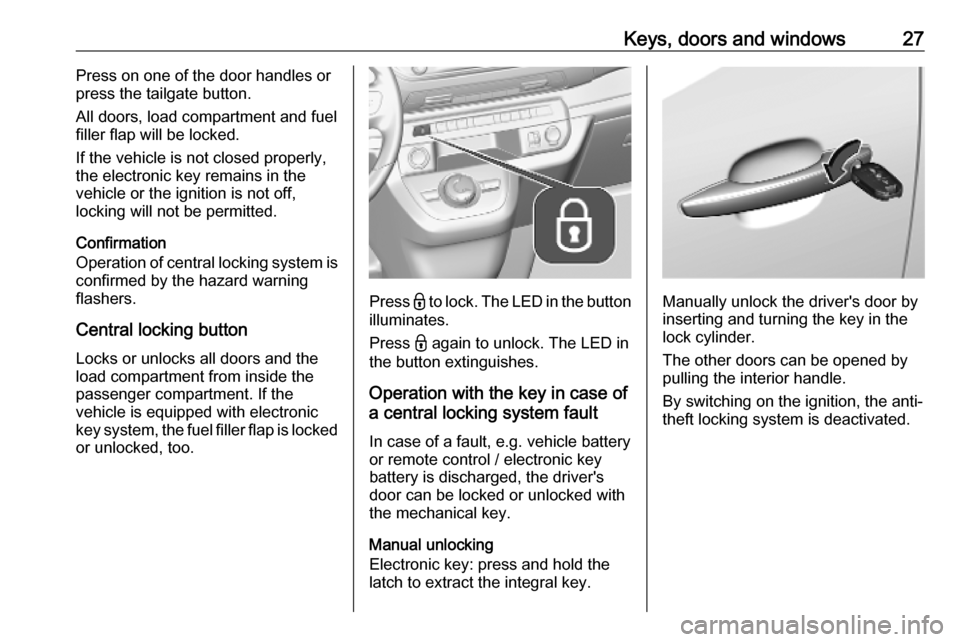
Keys, doors and windows27Press on one of the door handles or
press the tailgate button.
All doors, load compartment and fuel filler flap will be locked.
If the vehicle is not closed properly,
the electronic key remains in the
vehicle or the ignition is not off,
locking will not be permitted.
Confirmation
Operation of central locking system is
confirmed by the hazard warning
flashers.
Central locking button
Locks or unlocks all doors and the
load compartment from inside the
passenger compartment. If the
vehicle is equipped with electronic
key system, the fuel filler flap is locked or unlocked, too.
Press - to lock. The LED in the button
illuminates.
Press - again to unlock. The LED in
the button extinguishes.
Operation with the key in case of
a central locking system fault
In case of a fault, e.g. vehicle battery
or remote control / electronic key
battery is discharged, the driver's
door can be locked or unlocked with
the mechanical key.
Manual unlocking
Electronic key: press and hold the
latch to extract the integral key.Manually unlock the driver's door by
inserting and turning the key in the
lock cylinder.
The other doors can be opened by
pulling the interior handle.
By switching on the ignition, the anti-
theft locking system is deactivated.
Page 30 of 289
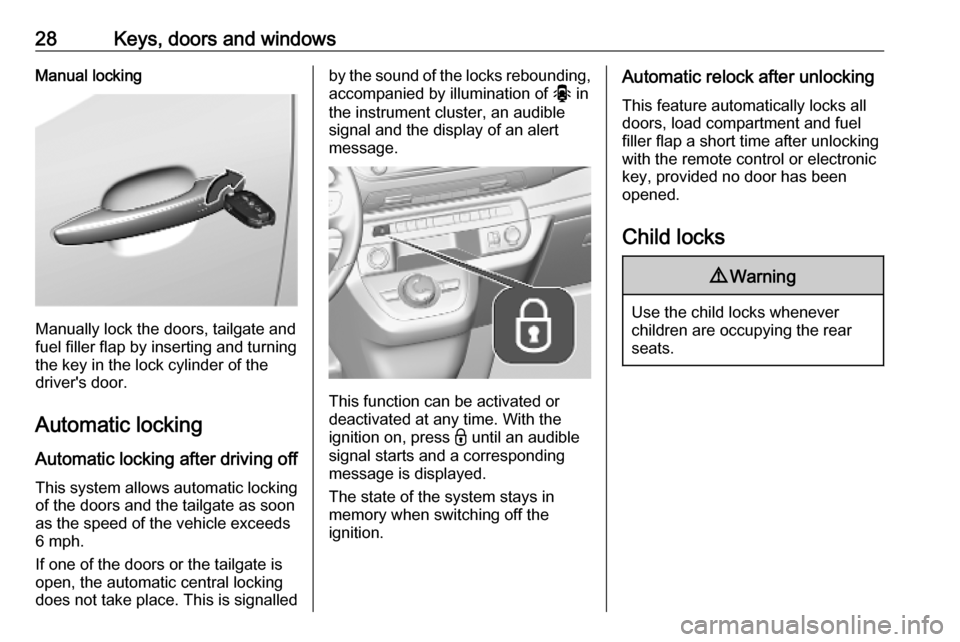
28Keys, doors and windowsManual locking
Manually lock the doors, tailgate and
fuel filler flap by inserting and turning the key in the lock cylinder of the
driver's door.
Automatic locking Automatic locking after driving off
This system allows automatic locking of the doors and the tailgate as soon
as the speed of the vehicle exceeds
6 mph.
If one of the doors or the tailgate is
open, the automatic central locking
does not take place. This is signalled
by the sound of the locks rebounding, accompanied by illumination of N in
the instrument cluster, an audible
signal and the display of an alert
message.
This function can be activated or
deactivated at any time. With the
ignition on, press - until an audible
signal starts and a corresponding
message is displayed.
The state of the system stays in
memory when switching off the
ignition.
Automatic relock after unlocking
This feature automatically locks all
doors, load compartment and fuel
filler flap a short time after unlocking
with the remote control or electronic
key, provided no door has been
opened.
Child locks9 Warning
Use the child locks whenever
children are occupying the rear
seats.
Page 33 of 289
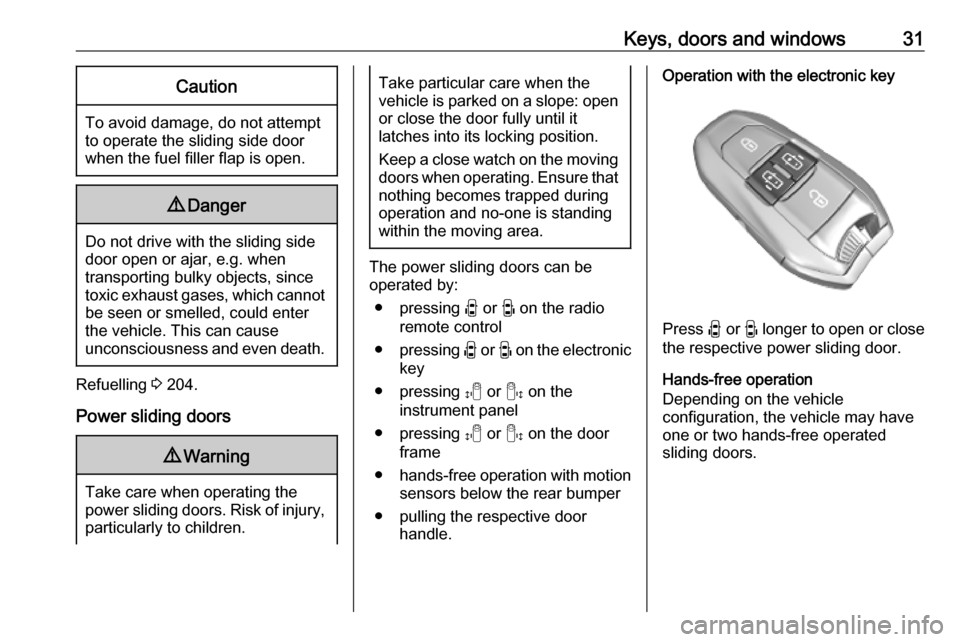
Keys, doors and windows31Caution
To avoid damage, do not attempt
to operate the sliding side door
when the fuel filler flap is open.
9 Danger
Do not drive with the sliding side
door open or ajar, e.g. when
transporting bulky objects, since
toxic exhaust gases, which cannot be seen or smelled, could enter
the vehicle. This can cause
unconsciousness and even death.
Refuelling 3 204.
Power sliding doors
9 Warning
Take care when operating the
power sliding doors. Risk of injury, particularly to children.
Take particular care when the
vehicle is parked on a slope: open
or close the door fully until it
latches into its locking position.
Keep a close watch on the moving doors when operating. Ensure that
nothing becomes trapped during
operation and no-one is standing
within the moving area.
The power sliding doors can be
operated by:
● pressing N or M on the radio
remote control
● pressing N or M on the electronic
key
● pressing P or O on the
instrument panel
● pressing P or O on the door
frame
● hands-free operation with motion
sensors below the rear bumper
● pulling the respective door handle.
Operation with the electronic key
Press N or M longer to open or close
the respective power sliding door.
Hands-free operation
Depending on the vehicle
configuration, the vehicle may have
one or two hands-free operated
sliding doors.
Page 36 of 289
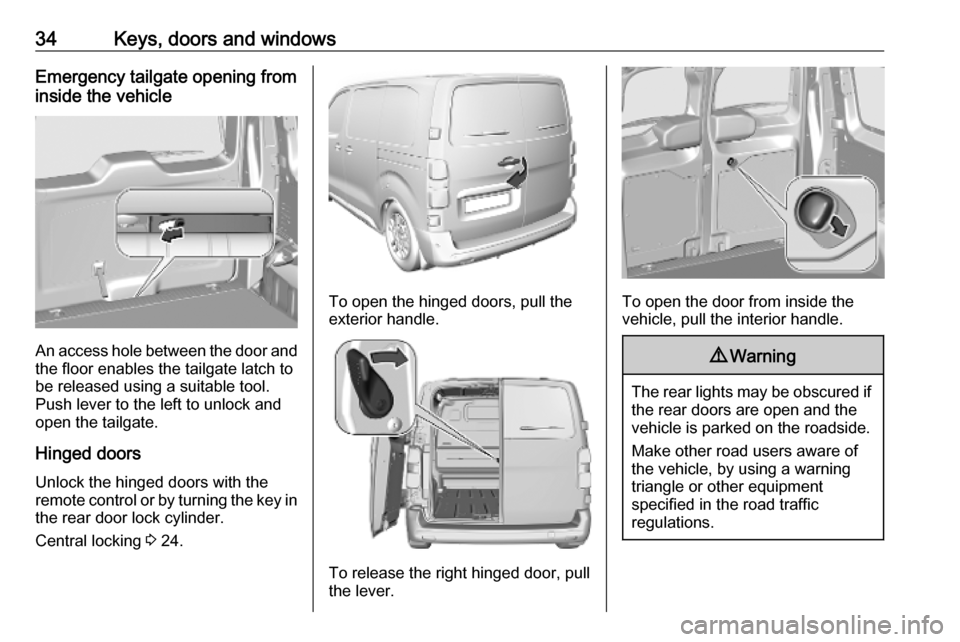
34Keys, doors and windowsEmergency tailgate opening from
inside the vehicle
An access hole between the door and the floor enables the tailgate latch tobe released using a suitable tool.
Push lever to the left to unlock and
open the tailgate.
Hinged doors
Unlock the hinged doors with the remote control or by turning the key in
the rear door lock cylinder.
Central locking 3 24.
To open the hinged doors, pull the
exterior handle.
To release the right hinged door, pull
the lever.
To open the door from inside the
vehicle, pull the interior handle.
9 Warning
The rear lights may be obscured if
the rear doors are open and the
vehicle is parked on the roadside.
Make other road users aware of the vehicle, by using a warning
triangle or other equipment
specified in the road traffic
regulations.